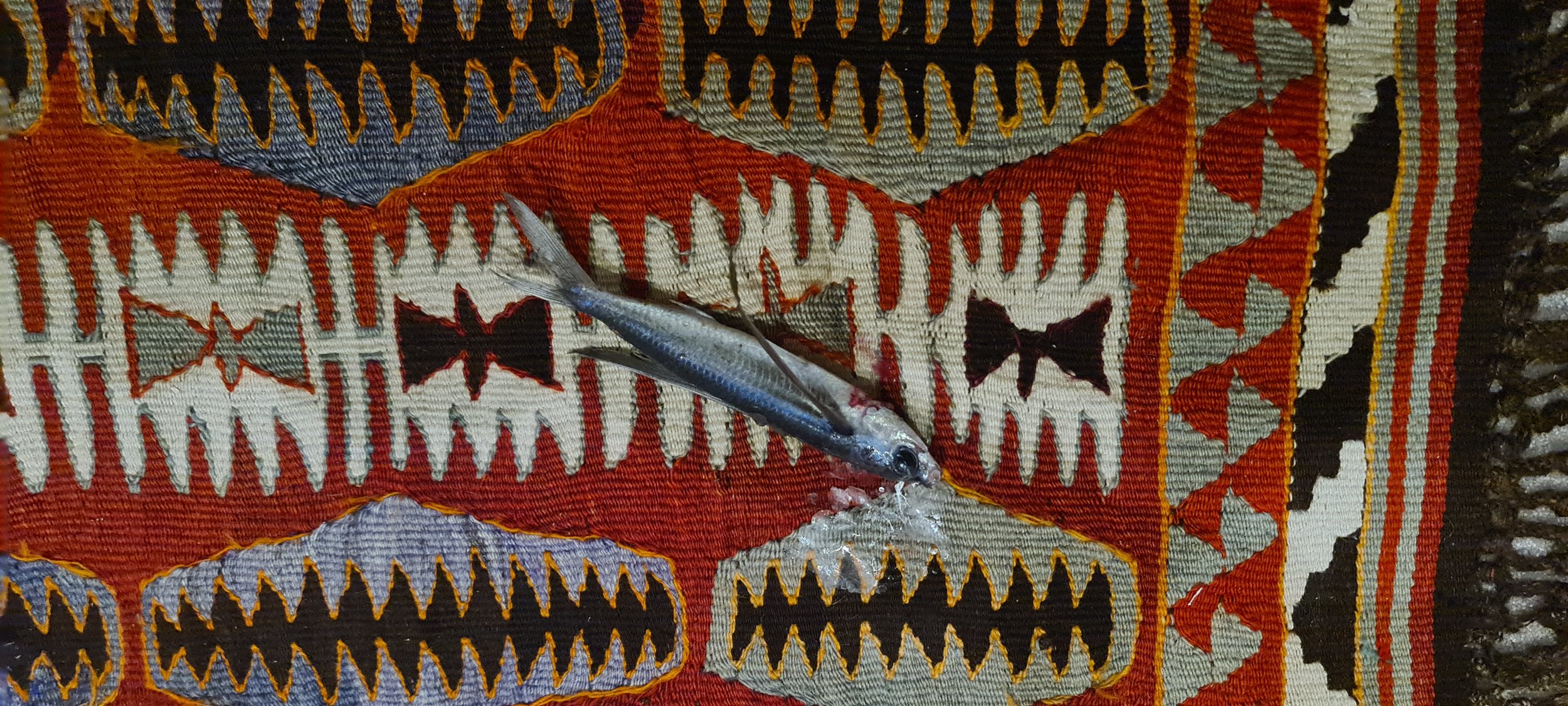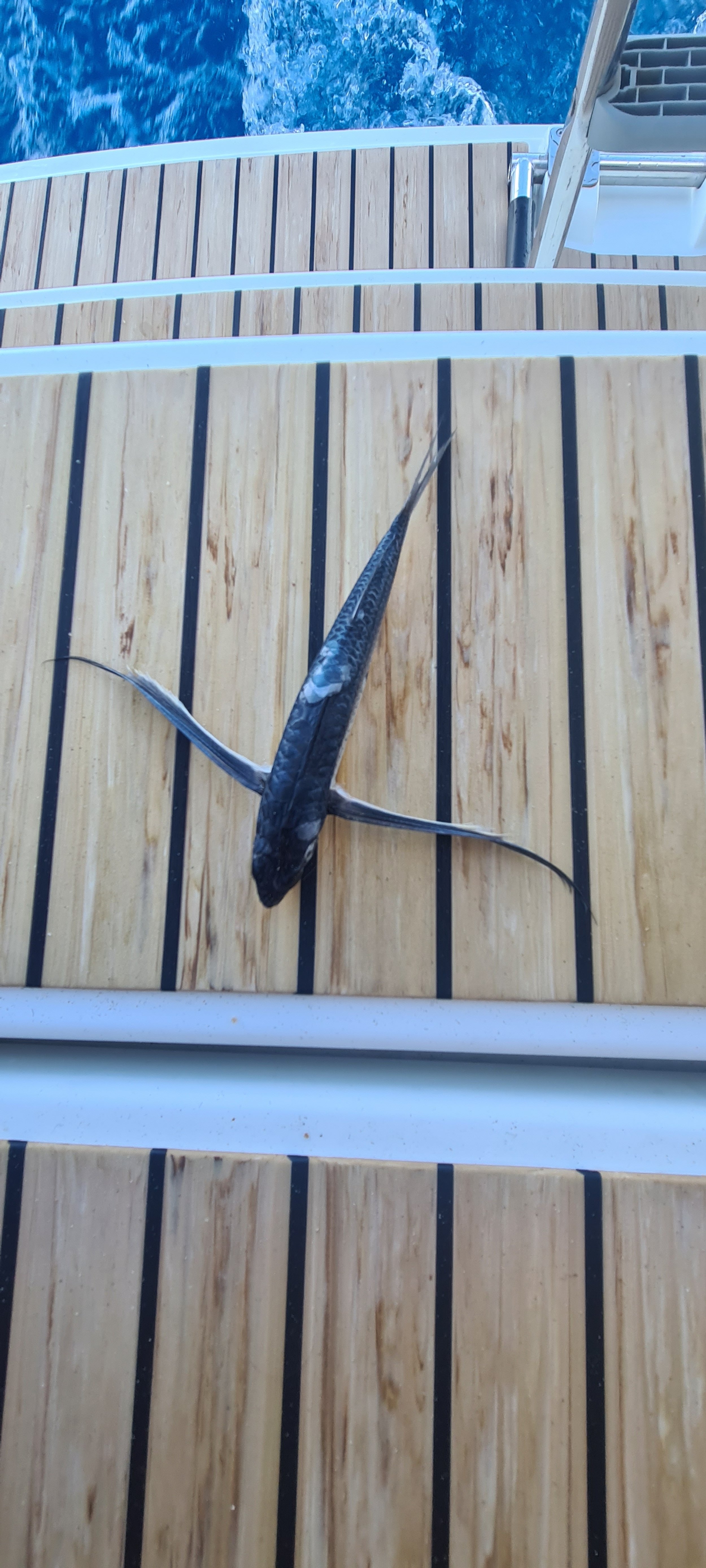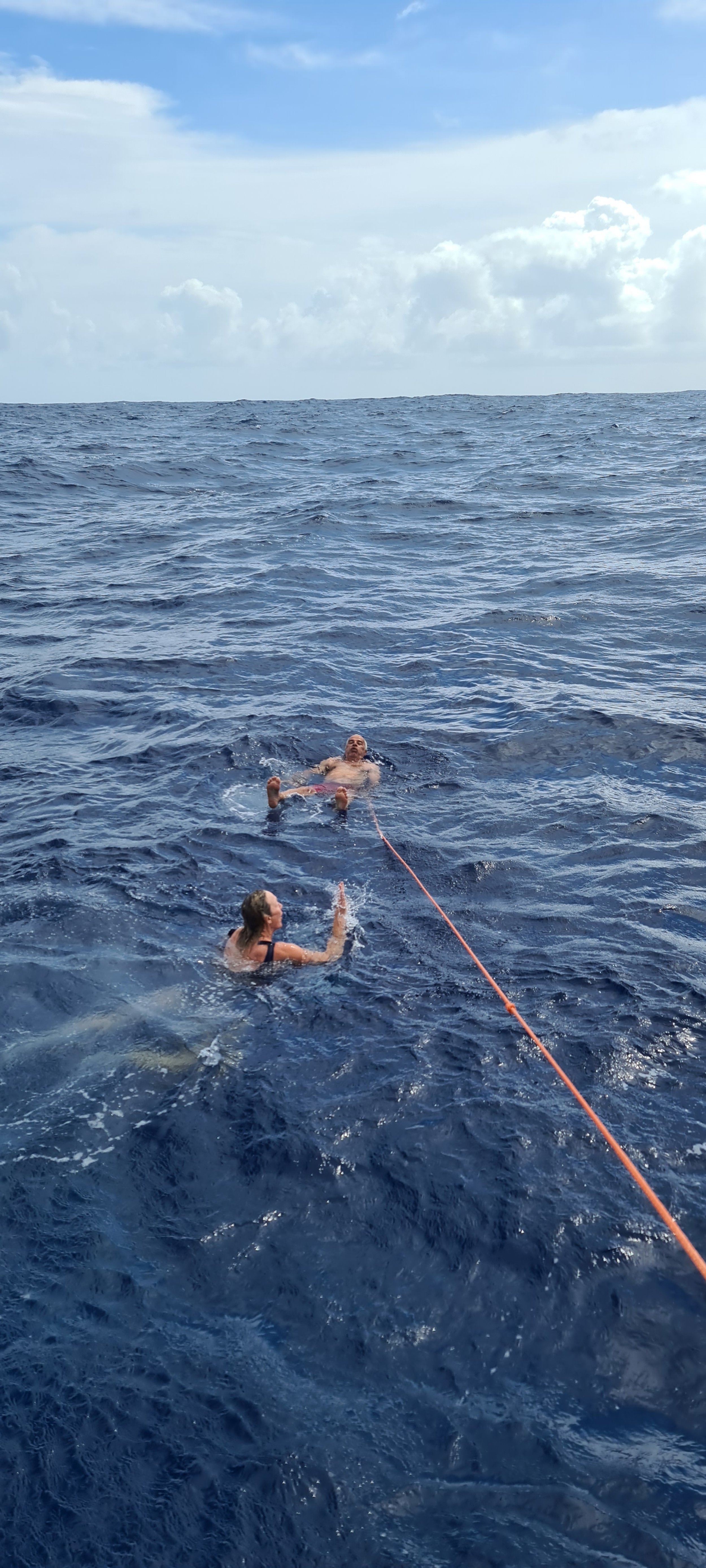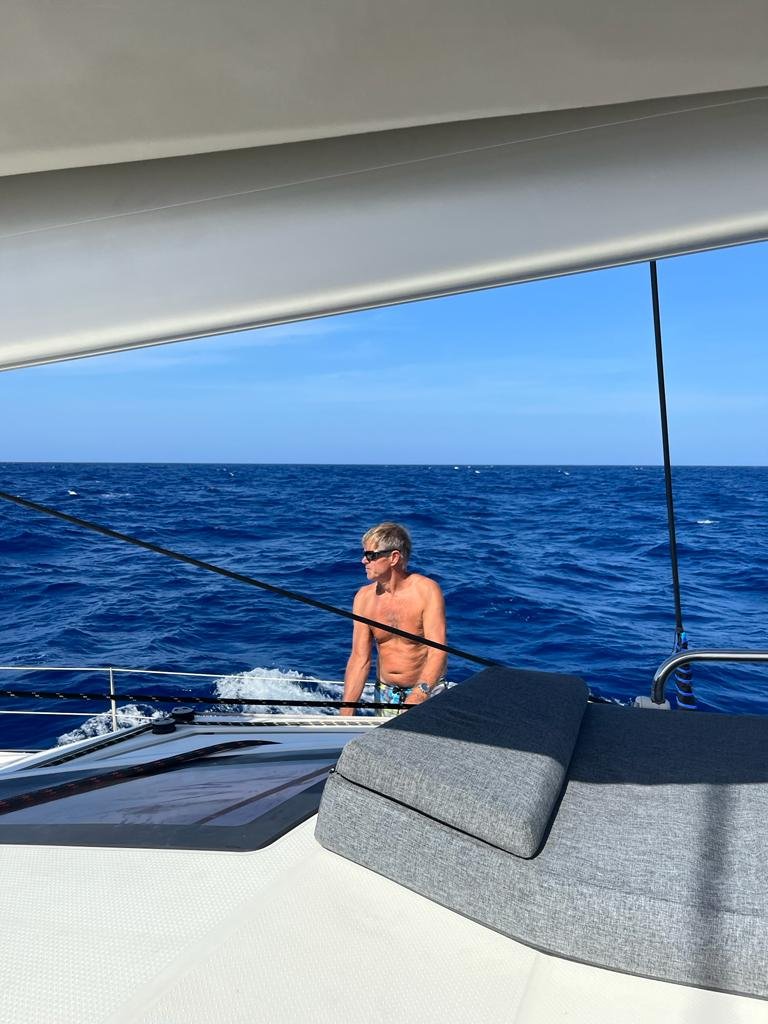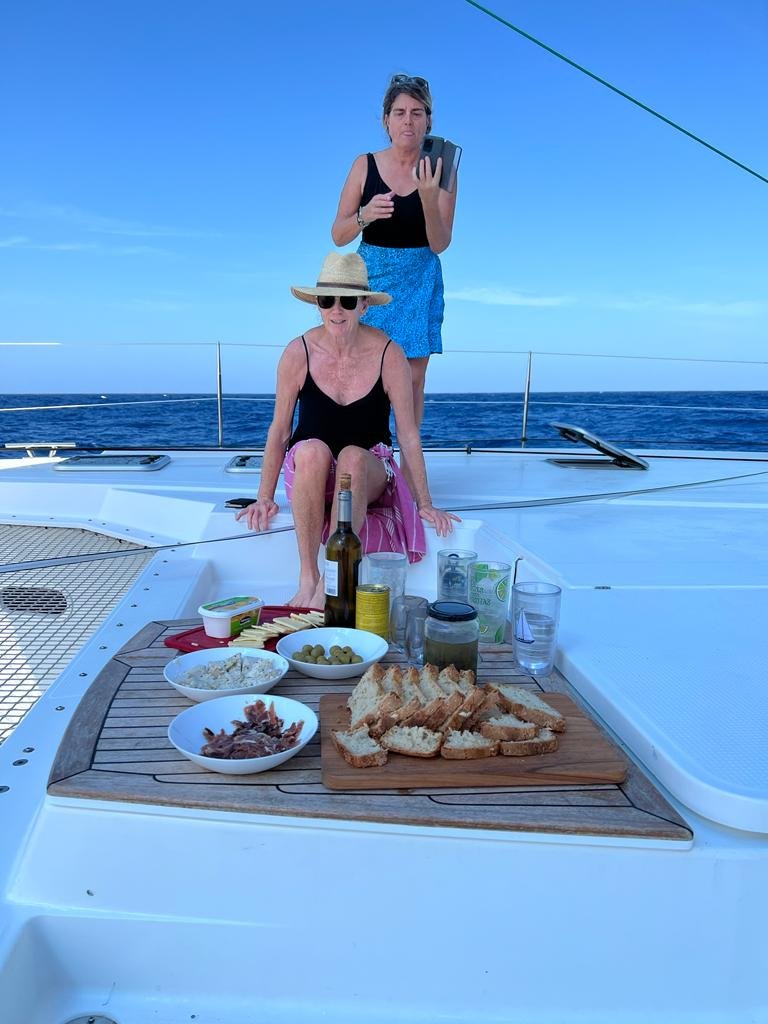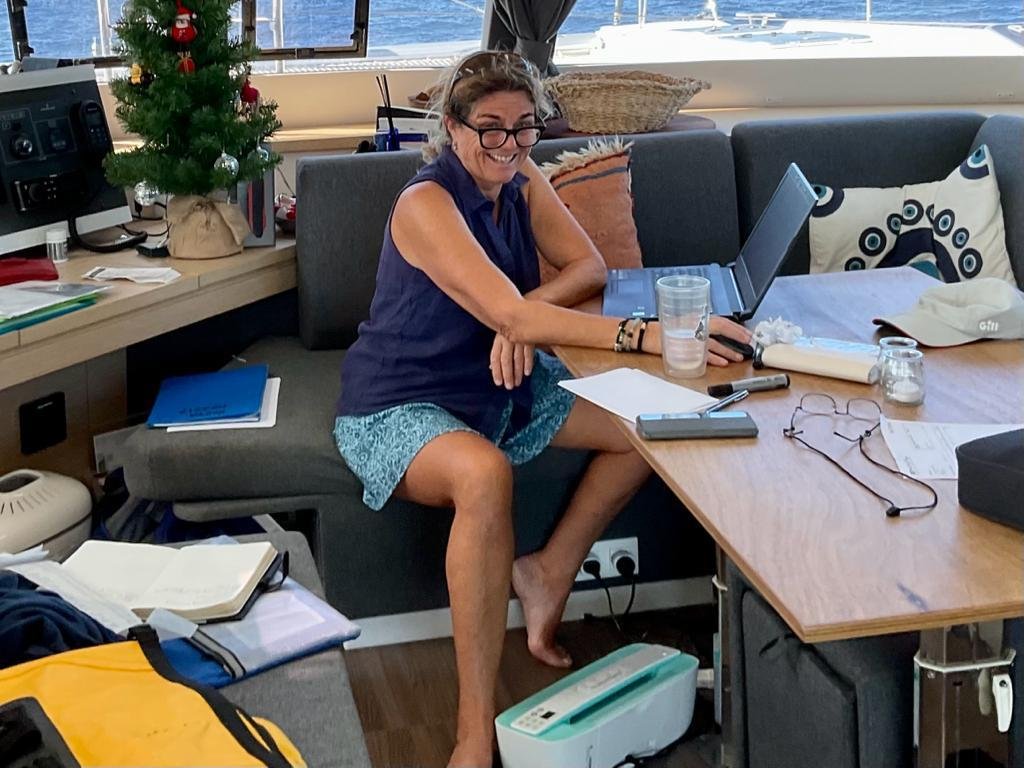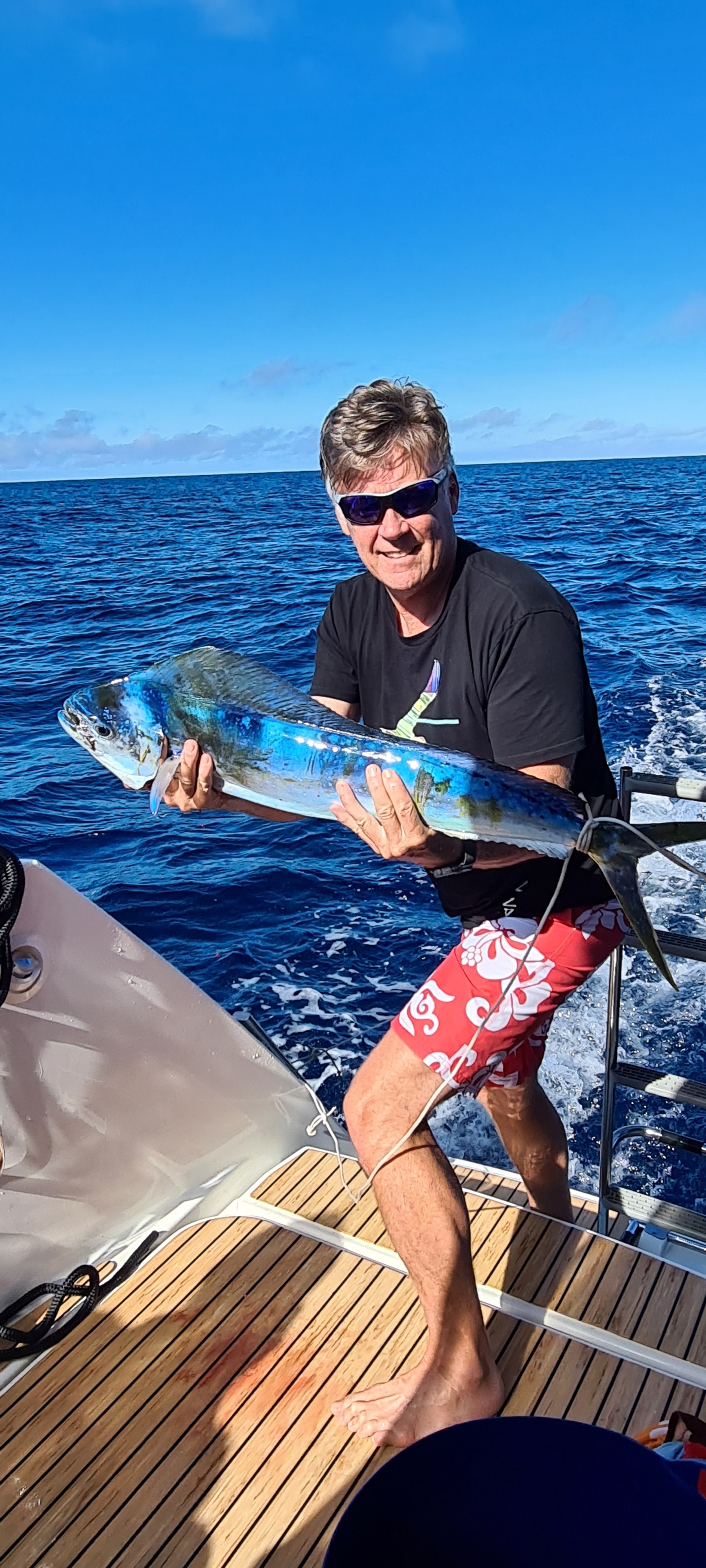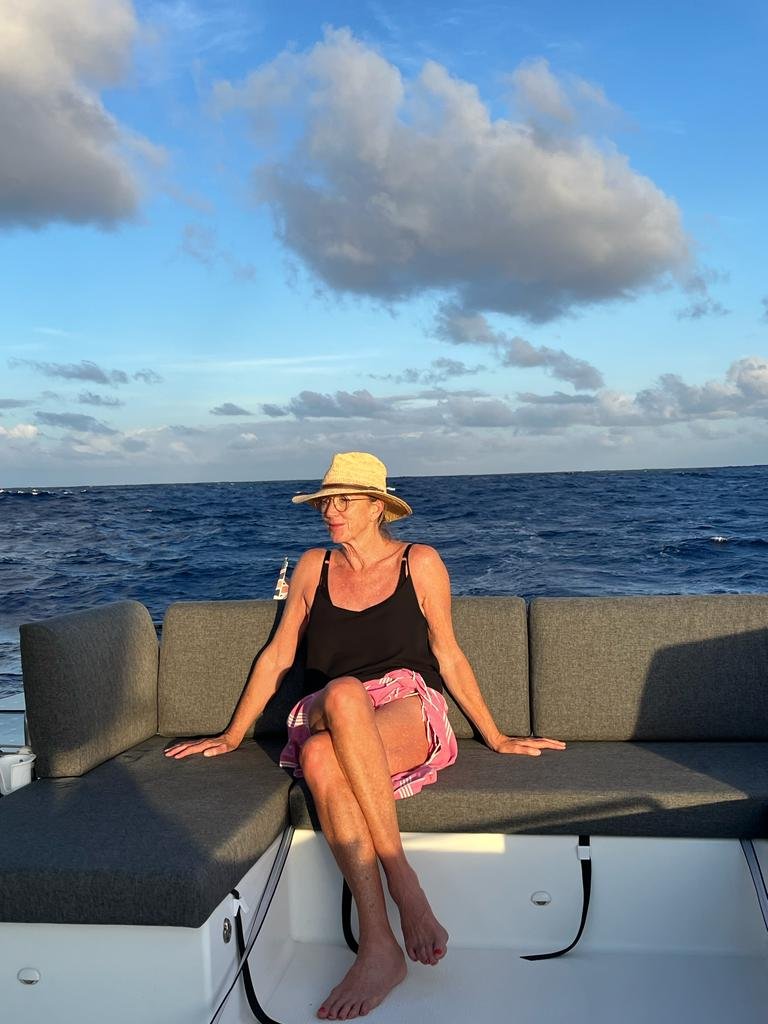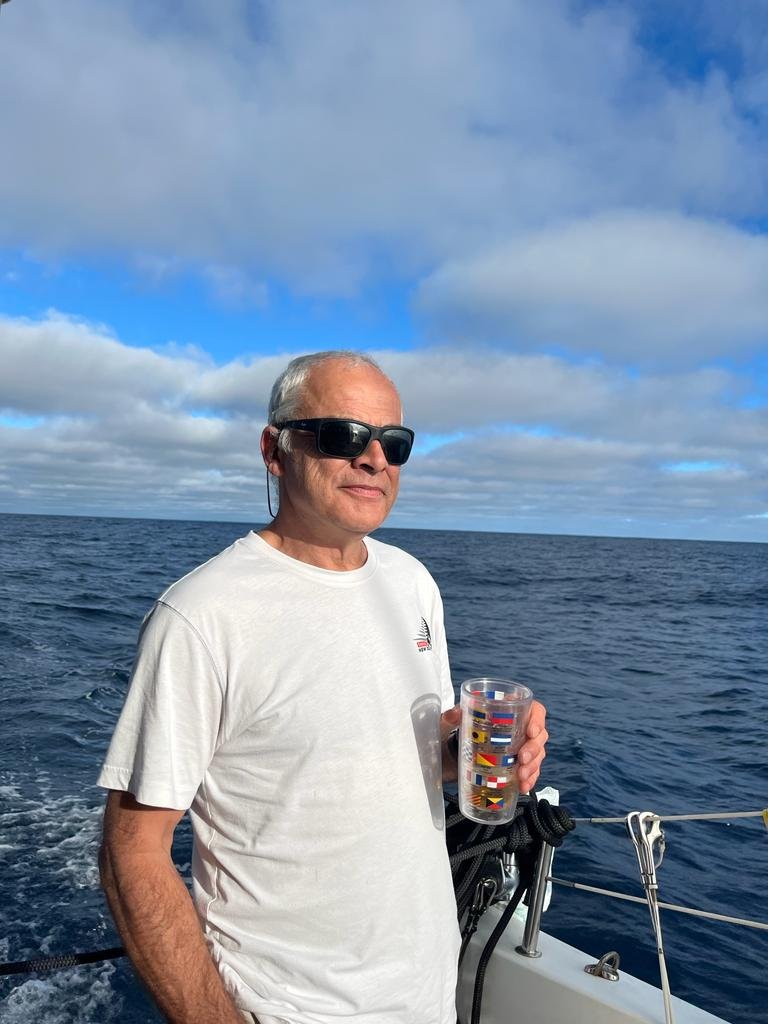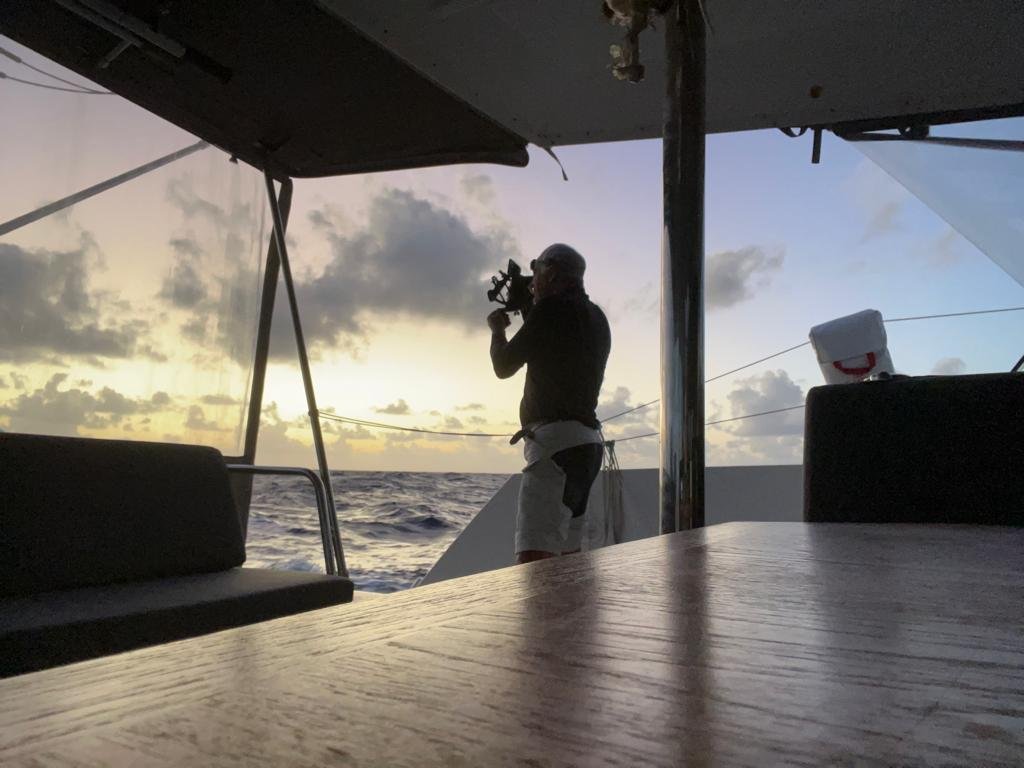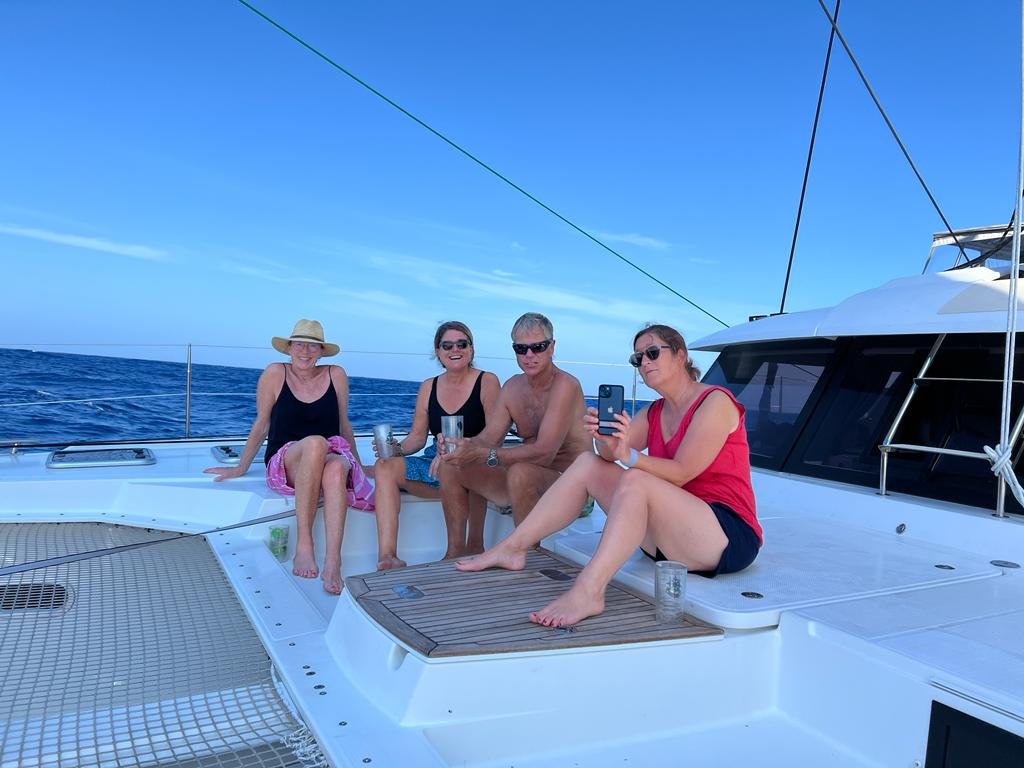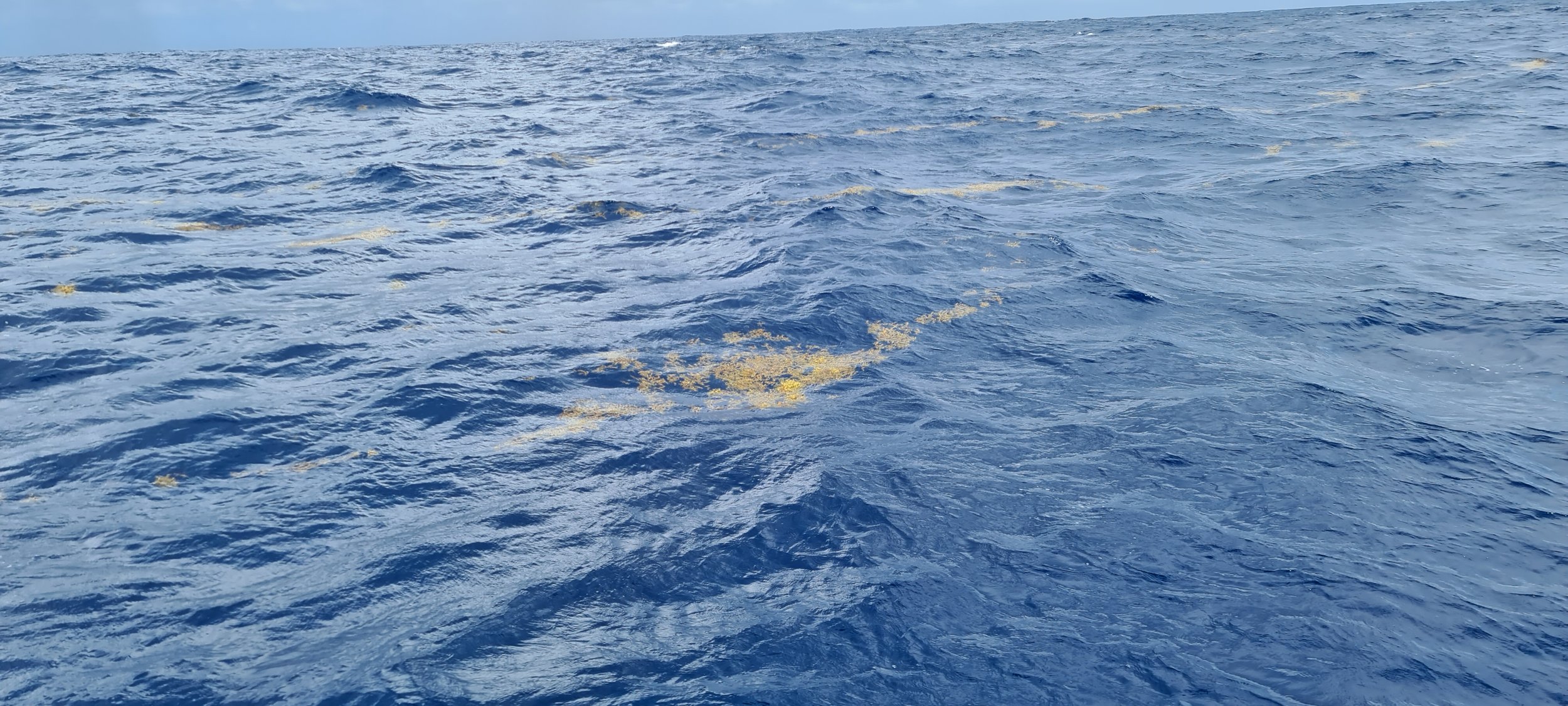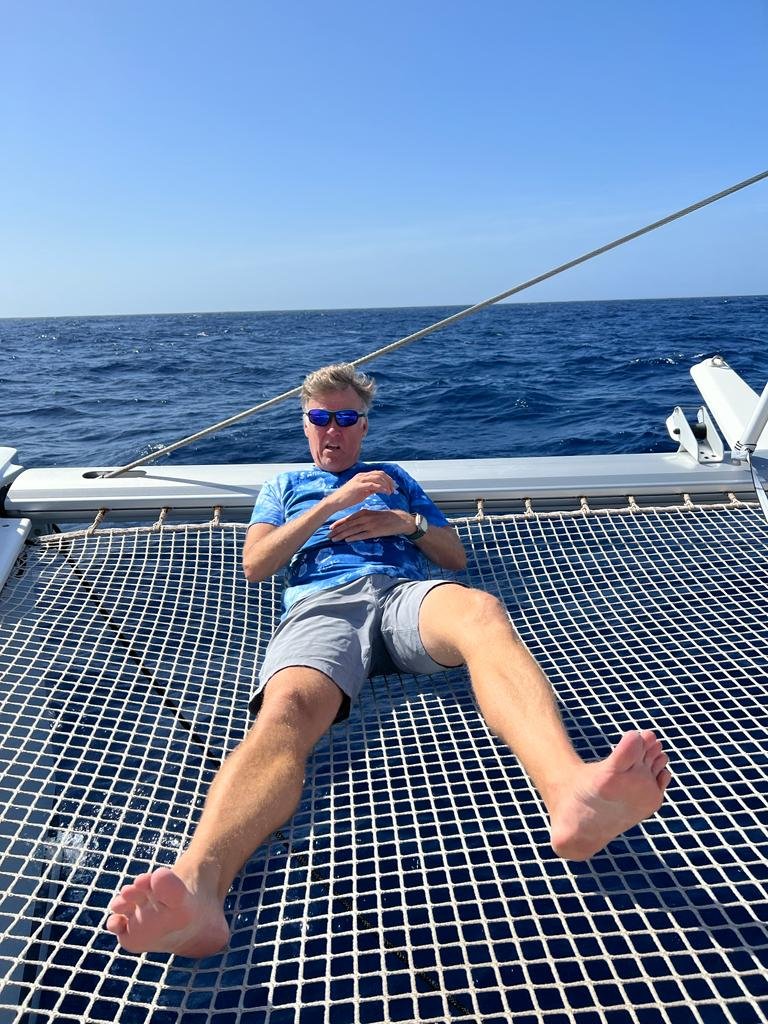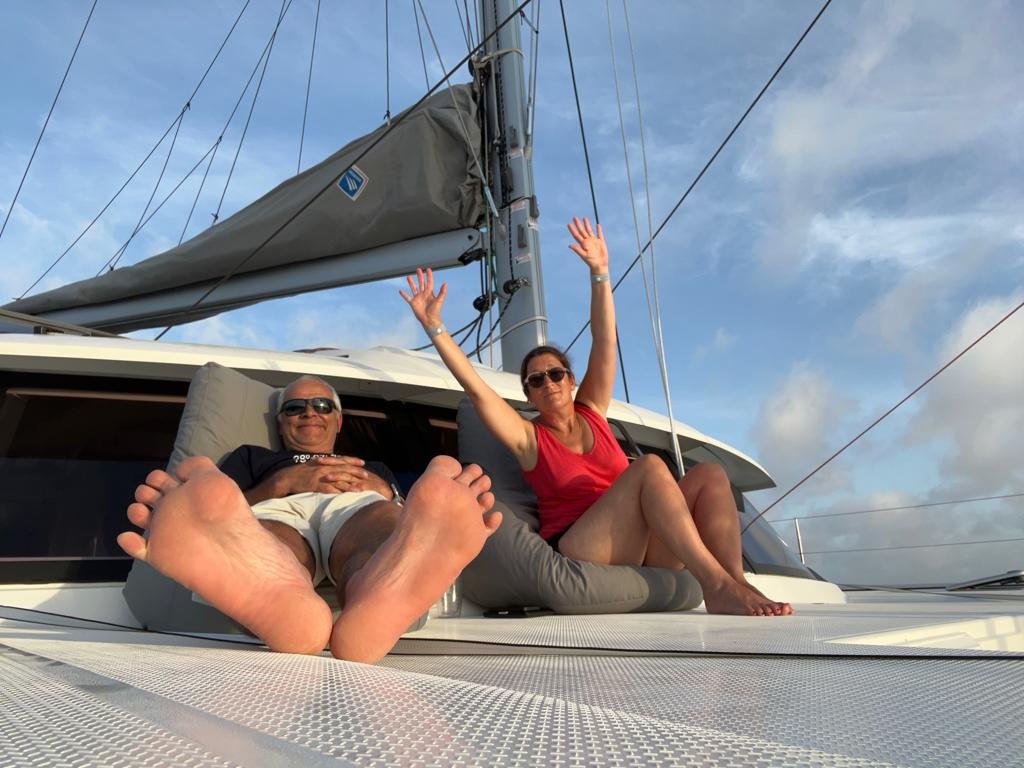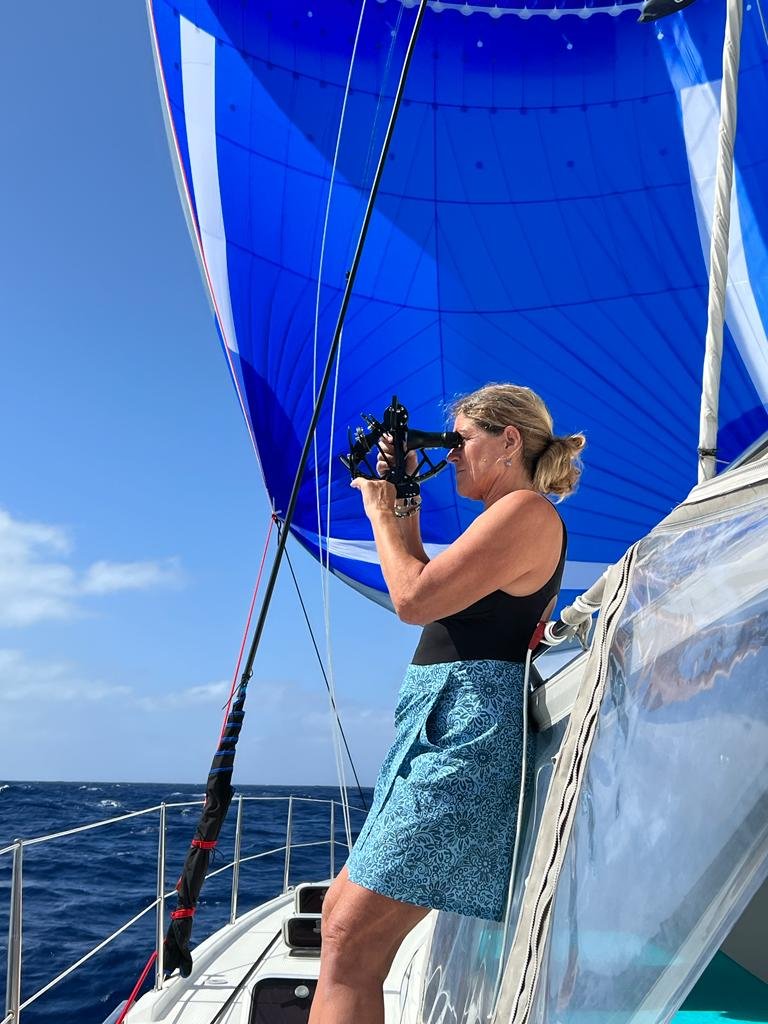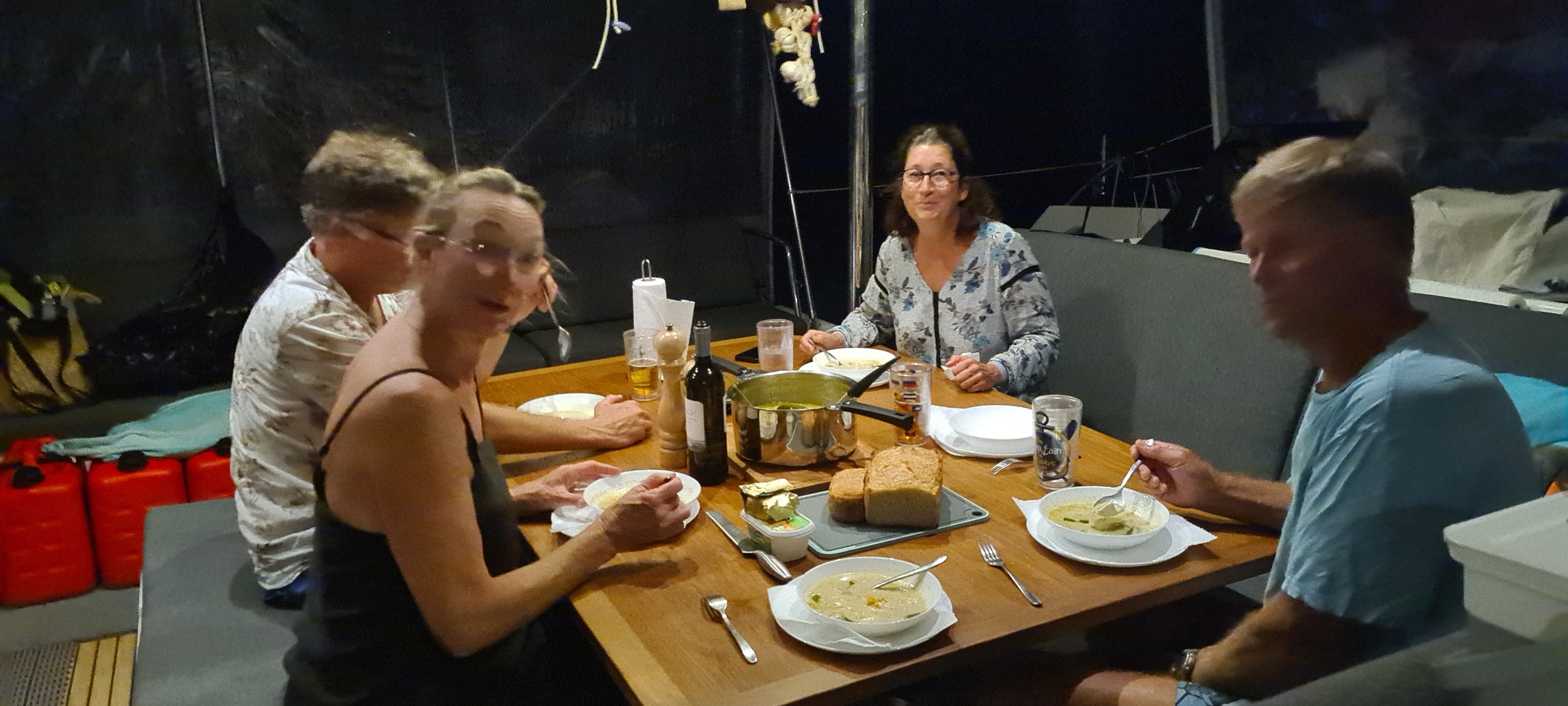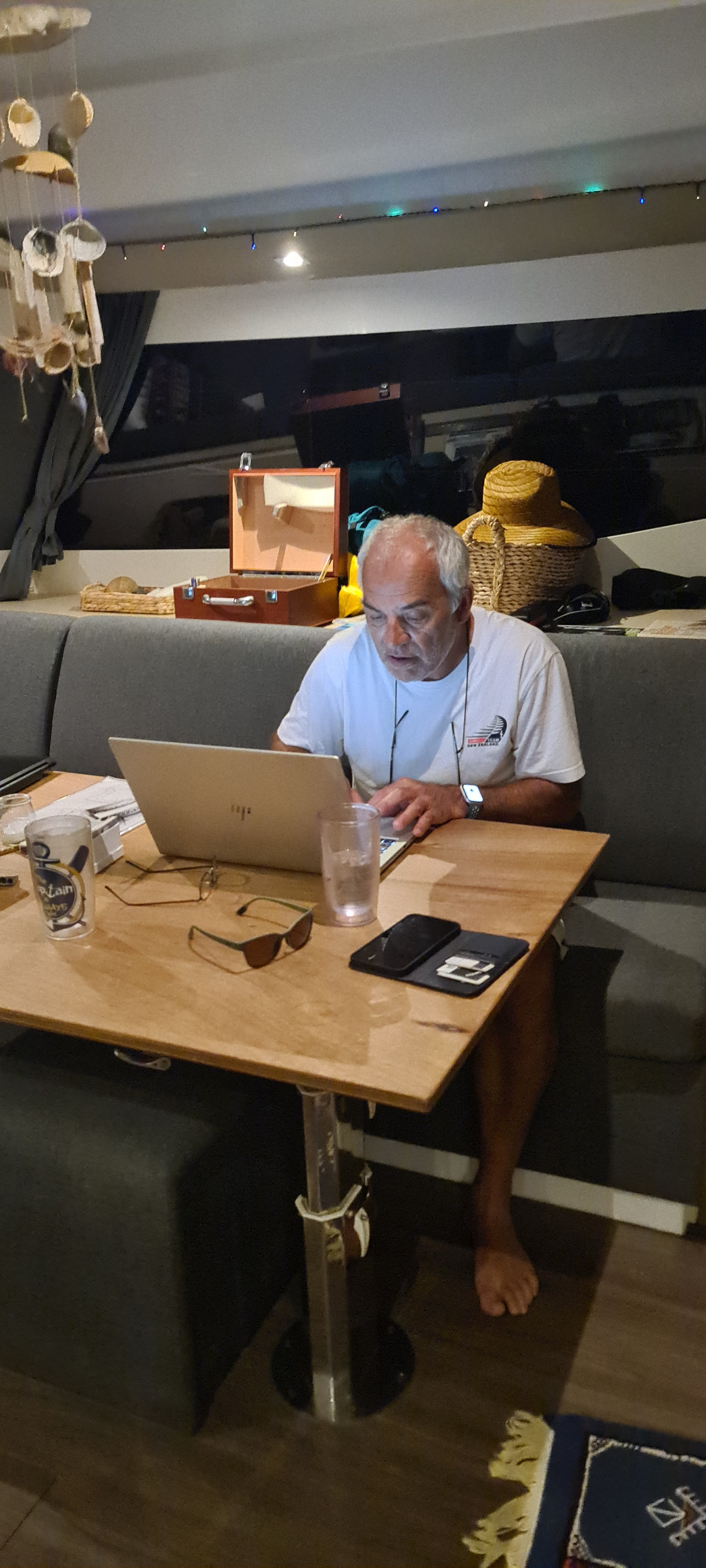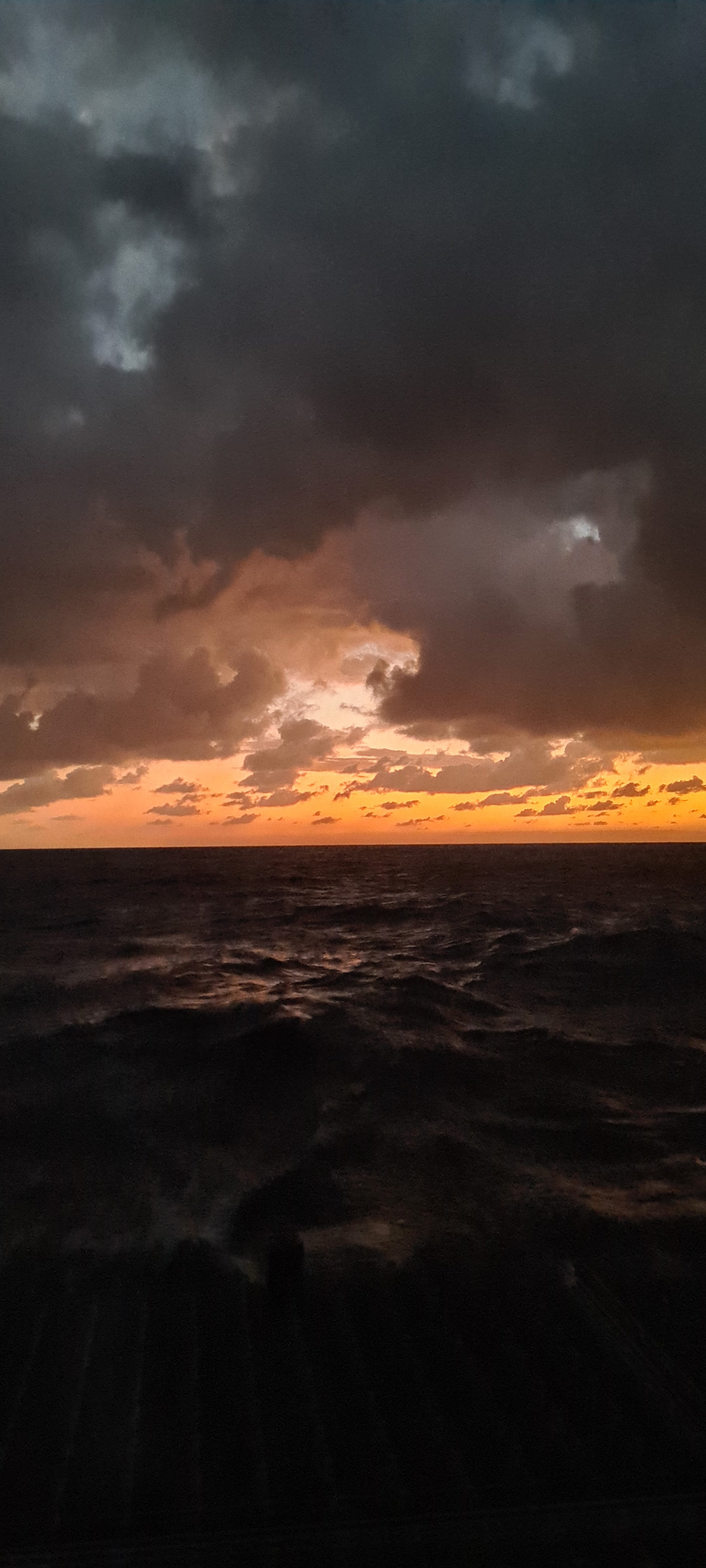The Atlantic
In the eleven and a half days it took us to cross the Atlantic, the wind was behind us most of the way, blowing from the east northeast and ranging between 15-25 knots, so we parasailed, our magnificent blue kite pulling us across the ocean. Wind strength varied with the time of day, mostly dying down at night, picking up early morning, dropping again during the day before picking up again at the end of the day. There was the odd squall the closer we got to the Caribbean but mainly it was sunny, hot, and humid, the sea and air temperature 26 degrees. There were two days around the middle of our passage when the wind fell away, so we dropped the parasail and motored, Skip pulling back on the throttle so we could have mid-Atlantic swims, an unreal feeling drifting over the swells so far from land.
Most nights we had flying visitors landing on our deck (or in Gregg’s case smacking his face), beautiful little fish and a squid, how do they jump so high? And so far! But not only on the deck, they kept turning up in the most obscure places, behind the herb garden, in TENDER, at the dinner table and one night in our cabin. Coming down after my watch, I became aware of a strange musky smell in our cabin, it wasn’t unpleasant so I thought no more about it, that is until Skip got up and stepped on a fish. Lying on my beautiful Turkish rug at the foot of our bed, the fish had wriggled its way across the deck and down through our overhead hatch screen, quite clever, Skip didn’t think so.
So how did we pass the time when we weren’t sleeping or eating? Reading. I quickly consumed all the six Robert Galbraith (aka J.K. Rowling) Cormoran Strike books then took on James Michener’s Caribbean to get a fast track history on where we were headed. Quite surreal to think that we were on the same route slave traders had taken only 300 years ago. And when we weren’t reading, we talked about food and the weather. Forecasting, route planning, sail trimming, wind direction, wind strength, Maggie and I also spent a lot of time bouncing meal ideas off each other, I believe the rest of the crew appreciated our culinary experimentation.
Between the six of us we had complimentary experience and expertise, and great compatibility; we played with each other and to our strengths. Roles in the order of our watches were -
Skip: Captain, and head of repairs, maintenance, gin and tonic
Cate aka First mate aka Cici: Chef de cuisine, and chief technology officer responsible for satellite weather updates and communications
Gregg: Deputy captain, the other R&M guy, chief dorado catcher, filleter, sashimi maker, also beer manager
Maggie: Sous chef, wine manager, stainless polisher extraordinaire
Dom: Navigateur, professeur celeste, directeur adjoint de la bière et régleur de voile
Anita: Personne qui fait du pain et mousse au chocolat et gâteau remarquable. All despite feeling seasick the whole voyage.
Highlights
1. Food (including five meals from our trip between the Canaries and Capo Verde)
Day 1: Mexican beef tortillas with salsa, lettuce and guacamole
Day 2: Sashimi followed by Ottolenghi chicken, caramelized onion, cardamon rice and green salad
Day 3: Sashimi followed by Skip’s birthday dinner of lambchops, turmeric golden potatoes, green salad and banana cake
Day 4: Fish and chips with tartare sauce and green salad
Day 5: Spanish spicy chorizo, tomatoes, parsley and chickpeas
Day 6: Nautilus in Mindelo - chef’s night off
Day 7: Marinated lemon chicken, spring onions, celery salad with garlic croutons
Day 8: Arabic mejadra lentils, coleslaw and ginger garlic BBQ fish
Day 9: Sashimi followed by Spanish sausages, zucchini salad and garlic potato mash
Day 10: Sashimi followed by homemade dough pizza
Day 11: Thai fish curry and homemade bread
Day 12: Ricotta spinach cannelloni and harvest chicken, followed by chocolate cake
Day 13: Halfway celebration Spanish bubbly cava, papadelle duck ragou and coleslaw
Day 14: Lemon chilli Spanish meatballs with wild rice and beetroot, walnut feta salad
Day 15: Meatloaf, spicy BBQ sauce, garlic mashed potatoes and peas
Day 16: Vietnamese pork with lemon grass, ginger, beans and wild rice with a fresh tomato salad
Day 17: Prawn, leek and chorizo soup with homemade bread and aioli
Day 18: Chorizo and beef stroganoff with baked potatoes, padron peppers and aioli, followed by chocolate mousse
Lunches were more of a help yourself affair, with plenty of homemade bread, cheese, jamon, olives, and capers except when Dom exhibited his culinary skills and made delicious mushroom omelettes.
2. Catching Fish. Dorado (also known as mahi mahi) are beautiful, with blue and yellow colouring that quickly fades as they die. Whenever we pulled one in, I felt sad, said a little prayer thanking it for giving us its life, then hypocritically enjoyed eating it. They are a delicious fish and Gregg an expert on preparation with sashimi featuring on our menu on catch day. We had managed to catch three on our way down to Cape Verde, then another two, several days later as we headed west. But as we got closer to the Caribbean, it got more difficult to keep the lines weed free, so in the end the fishermen retired.
Weed, well its actually an algae called Sargassum (Sargassum sp.), and there are golden brown streams and rafts of it on the sea surface. It has been called the golden rainforest of the ocean as it provides a refuge and ecosystem for many species of sea life. It is an interesting algae, it is holopelagic, meaning it spends its entire life cycle floating on the sea kept afloat by small air filled berries (pneumatocysyts) and it has been around for a very long time. First recorded by Columbus on his 1492 voyage across the Atlantic, there is a vast swathe of Sargassum in an area bounded by four currents, now known as the Sargasso Sea, it is the only sea on earth with no land boundaries. The weed has spread and increased dramatically over the past decade and is becoming a sight and smell problem washing up on Caribbean, Mexican and Florida beaches. Thought to be a result of increased deforestation and agricultural runoff, particularly in South America, attempts are being made to utilise it for fertiliser, compost and biofuel.
3. Sailing with our parasail most of the way, the maximum wind we experienced was 29.6 knots, the maximum speed we attained was a 16.5 knot surf, but overall we averaged 7.7 knots. Our first bow picnic under a blue sky and sail was perfect.
4. Having mid-Atlantic swims.
5. Reliable satellite communications. The Iridium network worked well, everyone was able to text or email loved ones back home, and we were able to download twice daily weather reports and routing suggestions as well as upload our GPS track to Predictwind.
6. Learning how to use a sextant. Skip had bought me a sextant for my birthday just before we set sail on NOETA and it had been sitting patiently in our cabin, waiting for the right moment to come out of its box. Dom had used one when he was a navigator in the French Navy and had downloaded all the necessary almanac tables, so midday sessions saw us taking sights, calculating mathematical equations, and coming up with the correct latitude, great feeling.
7. Discovering we could see Crux, the Southern Cross and Polaris, the North Star, at the same time. Skip said I think I can see the Southern Cross and most of us said, no, that can’t be possible from the northern hemisphere, but he was right, only possible below 26 degrees and before dawn, he dined out on it for several nights.
Finally at 0125 on December 24th, we arrived in Martinique. It had taken us a month to get there from Gibraltar, we had put our clocks back four times and covered 3,768 nautical miles.
Merry Christmas!

